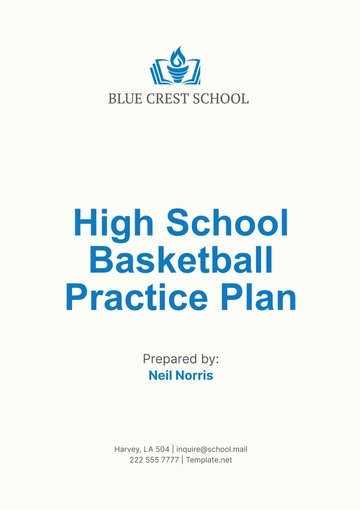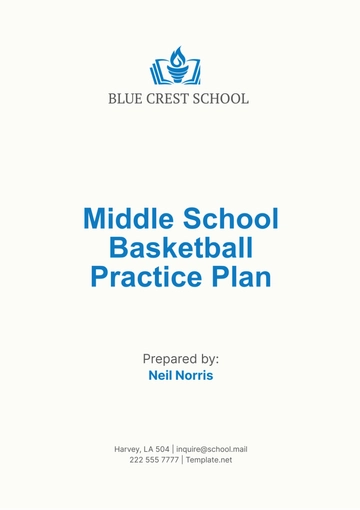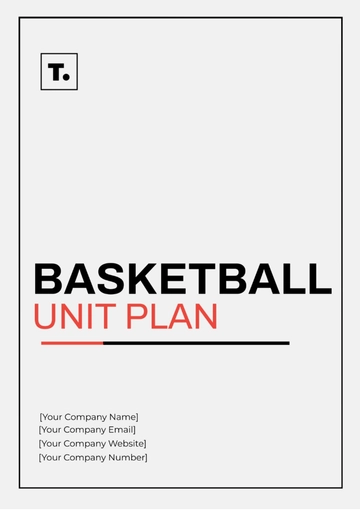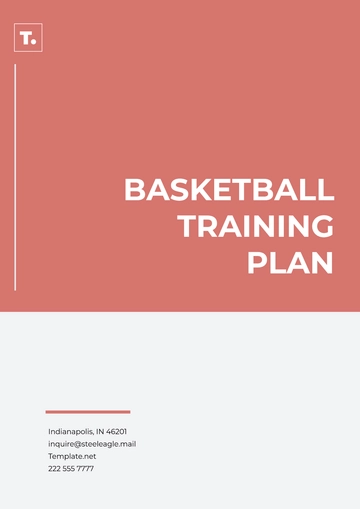Free Middle School Basketball Practice Plan
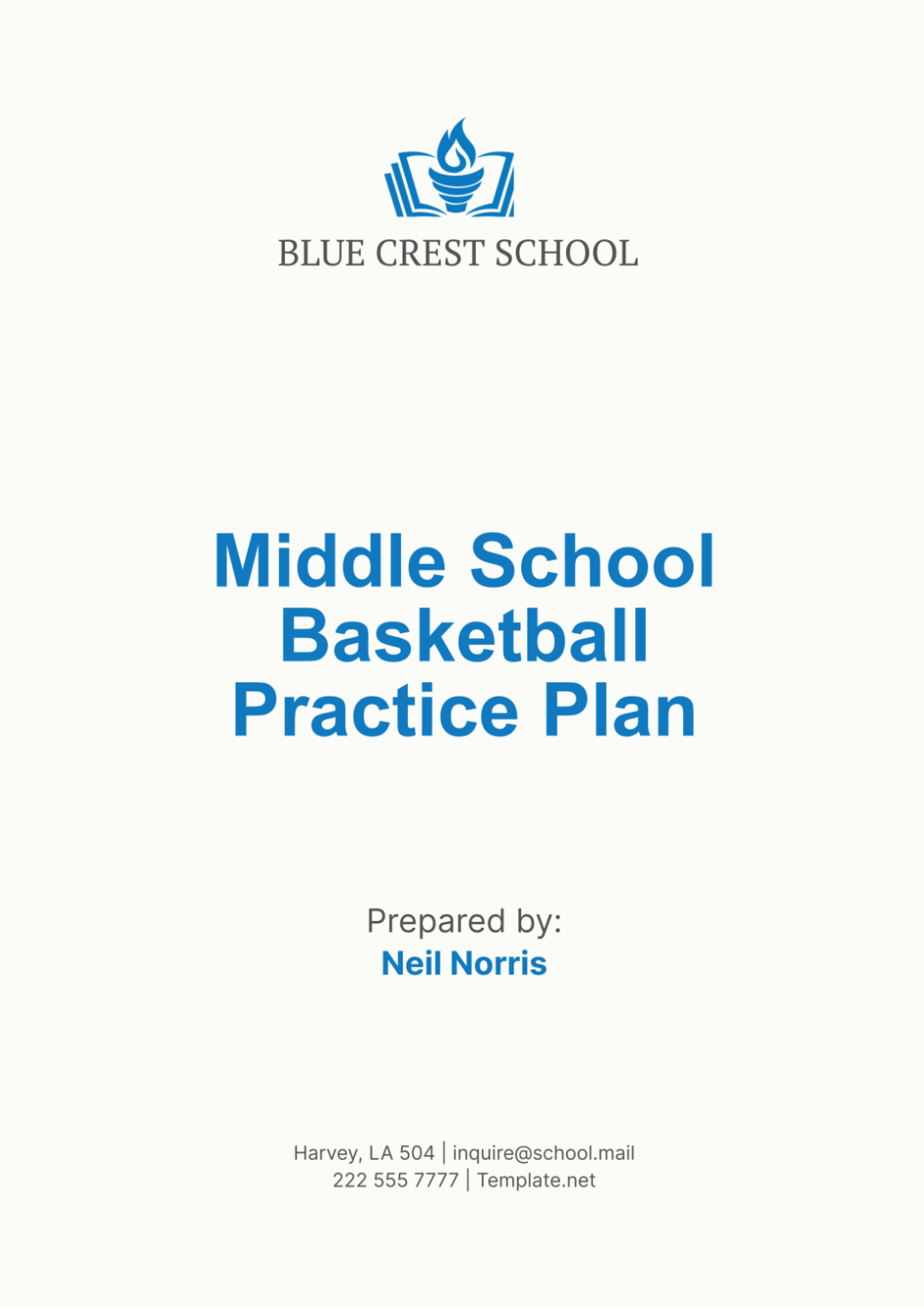
I. Overview
The purpose of this practice plan is to create a structured and comprehensive training session for the middle school basketball team at [Your Company Name]. The primary objectives for today's practice session are to enhance fundamental basketball skills, improve team coordination, and build physical conditioning. By following this detailed plan, players will develop their abilities in dribbling, passing, shooting, defense, and overall game strategy. This practice plan is designed to ensure that each player receives adequate attention and that the team as a whole functions cohesively.
Basketball, being a team sport, requires players to not only excel individually but also to understand and execute plays collectively. The practice will be divided into several segments, each focusing on a specific aspect of the game. Through consistent practice, the team will build a strong foundation of skills that are essential for competitive play. Furthermore, the practice session aims to instill discipline, teamwork, and sportsmanship among the players.
II. Warm-Up
The warm-up session is crucial as it prepares the players' bodies for the physical demands of basketball practice. It reduces the risk of injuries and enhances performance by increasing blood flow to the muscles and improving flexibility.
A. Dynamic Stretching (5-10 minutes)
Dynamic stretching involves movements that are designed to stretch and warm up the muscles. This type of stretching is more effective for basketball players as it mimics the movements they will perform during the game.
High Knees: Players will jog in place while lifting their knees high towards their chest. This exercise helps in warming up the hip flexors and the quadriceps.
Butt Kicks: Players will jog in place, kicking their heels up towards their glutes. This movement stretches the quadriceps and enhances coordination.
Arm Circles: Players will extend their arms and make circular motions, first small and then gradually increasing in size. This exercise helps in warming up the shoulder muscles and improving range of motion.
B. Light Jogging (5 minutes)
After dynamic stretching, players will engage in light jogging around the court. This exercise elevates the heart rate and further warms up the muscles. Players should maintain a steady pace to avoid fatigue early in the practice.
III. Skill Development
Skill development is a critical part of basketball practice. This section focuses on enhancing the fundamental skills required for effective gameplay. Each drill is designed to improve specific aspects of a player's performance.
A. Dribbling Drills (10 minutes)
Dribbling is a core skill in basketball that requires control, coordination, and agility. Players will participate in various dribbling drills to enhance their ability to maneuver the ball under different conditions.
Basic Dribbling: Players will dribble the ball using both their dominant and non-dominant hands while maintaining control and speed. The coach will emphasize proper technique, including keeping the head up and using the fingertips to control the ball.
Crossovers: This drill focuses on changing direction while dribbling. Players will practice crossover dribbling to improve their agility and ability to evade defenders.
Dribbling Through Cones: Cones will be set up in a zigzag pattern, and players will dribble through them, focusing on quick changes in direction and maintaining control of the ball.
B. Passing Drills (10 minutes)
Passing is essential for effective teamwork and ball movement. These drills will help players improve their accuracy and timing in passing the ball to teammates.
Chest Passes: Players will practice chest passes, and will emphasize the importance of stepping into the pass and following through with their hands.
Bounce Passes: Players will practice bounce passes, which are particularly useful in tight defensive situations. The coach will instruct players to aim for a spot about two-thirds of the way to their target and to use a low, fast bounce.
Overhead Passes: This drill focuses on passing the ball over a defender's reach. Players will practice using both hands to throw the ball from above their head, ensuring the pass is accurate and powerful.
IV. Shooting Practice
Shooting is one of the most critical skills in basketball, requiring precision, confidence, and consistency. This section of the practice focuses on improving players' shooting techniques and their ability to score from various positions on the court.
A. Form Shooting (10 minutes)
Players will start with form shooting to focus on their shooting mechanics. This involves shooting from a close range, concentrating on the fundamentals such as hand placement, follow-through, and balance.
B. Shooting Drills (15 minutes)
These drills will help players develop their shooting skills under different conditions, mimicking game scenarios.
Free Throws: Players will practice shooting free throws to improve their consistency and accuracy. This drill also helps in building confidence under pressure, as free throws are critical in close games. Each player will take a series of shots, and the coach will provide feedback on their technique.
Layups: Layup drills will focus on finishing strong at the basket. Players will practice both right-handed and left-handed layups to ensure they can score effectively from either side of the court. The coach will emphasize the importance of using the backboard and maintaining control while driving to the basket.
Spot Shooting from Various Positions: Players will take shots from different spots on the court, including mid-range and three-point areas. This drill helps players develop a range of shooting abilities and prepares them for various scoring opportunities during a game. Players will rotate through different shooting spots, and the coach will provide tips on improving their shot selection and technique.
V. Defensive Drills
Defense is an integral part of basketball, requiring anticipation, agility, and teamwork. This section focuses on developing defensive skills and strategies that will help players effectively guard their opponents and prevent scoring.
A. Stance and Footwork (10 minutes)
Proper defensive stance and footwork are the foundations of effective defense. Players will work on maintaining a low, balanced stance and using quick, controlled movements to stay in front of their opponents.
Defensive Slides: Players will practice sliding side-to-side without crossing their feet, focusing on staying low and maintaining balance. This drill helps in developing lateral quickness and the ability to change directions rapidly.
Close-Out Drills: This drill involves players closing out on a shooter, aiming to contest the shot without fouling. Players will focus on sprinting towards the shooter, getting low, and using their hands to block the shot or force a difficult shot.
B. Team Defense Drills (15 minutes)
These drills will help players understand and execute team defensive strategies, improving their ability to work together to stop the opposing team.
2-on-2 Defensive Drills: Players will practice defending in pairs, focusing on communication and coordination. This drill helps players understand how to provide help defense and rotate effectively.
3-on-3 Half-Court Defense: In this drill, players will defend against three offensive players in a half-court setting. The focus will be on maintaining defensive spacing, communicating with teammates, and preventing easy scoring opportunities. This drill simulates real-game scenarios and helps players develop their defensive instincts and teamwork.
VI. Conditioning
Conditioning is a vital aspect of basketball practice, as it enhances players' endurance, speed, and overall physical fitness. At [Your Company Name], the conditioning segment focuses on high-intensity drills that mimic the physical demands of a basketball game. This section ensures that players can maintain a high level of performance throughout the game.
A. Sprint Drills (10 minutes)
Sprint drills are designed to improve players' speed and agility. These drills also help in developing explosive power, which is essential for quick movements on the court.
Suicides: Players will run to various lines on the court (free throw line, half-court line, opposite free throw line, and baseline), touching each line before sprinting back to the starting point. This drill builds endurance and simulates the short bursts of speed required during a game.
Full-Court Sprints: Players will sprint from one baseline to the other and back. This drill focuses on developing speed and maintaining high-intensity effort over a longer distance. It also helps in building cardiovascular endurance.
B. Agility Drills (10 minutes)
Agility drills improve players' ability to change direction quickly and maintain control of their movements. These skills are crucial for both offensive and defensive play.
Ladder Drills: Using an agility ladder, players will perform various footwork patterns such as high knees, in-and-out steps, and lateral movements. This drill enhances foot speed, coordination, and agility.
Cone Drills: Cones will be set up in various patterns, and players will navigate through them using quick, controlled movements. This drill helps in improving reaction time and the ability to change directions rapidly.
Activity | Focus | Duration |
|---|---|---|
Sprint Drills | Speed and Endurance | 10 minutes |
Agility Drills | Quickness and Coordination | 10 minutes |
VII. Cool Down
The cool-down segment is essential for gradually bringing the players' heart rate down and promoting muscle recovery. It helps prevent stiffness and soreness after an intense practice session. The cool-down also provides an opportunity for reflection and team bonding.
A. Static Stretching (5-10 minutes)
Static stretching involves holding stretches for an extended period to improve flexibility and promote muscle relaxation. Players will stretch major muscle groups, including the hamstrings, quadriceps, calves, and shoulders. Each stretch should be held for 20-30 seconds, focusing on slow, deep breathing to enhance relaxation.
B. Team Discussion (5 minutes)
After stretching, the team will gather for a brief discussion. This session provides an opportunity to review the practice, address any concerns, and reinforce key takeaways. The coach will highlight the main points of the practice, discuss any areas that need improvement, and provide positive feedback. Players will be encouraged to share their thoughts and ask questions.
Activity | Focus | Duration |
|---|---|---|
Static Stretching | Flexibility and Relaxation | 5-10 minutes |
Team Discussion | Review and Feedback | 5 minutes |
VIII. Closing
The closing segment of the practice session is dedicated to wrapping up and preparing for future practices or games. This segment helps in maintaining organization and ensuring that all players are informed about upcoming events and expectations.
Announcements: The coach will provide updates on upcoming games, events, and any changes to the practice schedule. This ensures that all players are aware of important dates and can plan accordingly. The coach will also remind players of any equipment or uniform requirements and encourage them to maintain good academic performance, as balancing sports and academics is crucial for student-athletes.
Team Huddle: The team huddle is a tradition that fosters team unity and motivation. Players and coaches will come together in a circle, and the coach will deliver a motivational talk. The talk will focus on the importance of teamwork, dedication, and continuous improvement. The huddle concludes with a team cheer to boost morale and reinforce a sense of camaraderie.
Activity | Focus | Duration |
|---|---|---|
Announcements | Information and Updates | 5 minutes |
Team Huddle | Motivation and Unity | 5 minutes |
IX. Summary
The practice plan for [Your Company Name]'s middle school basketball team is designed to be comprehensive and effective in developing players' skills and physical fitness. Each section of the practice session has a specific focus, ensuring that all aspects of the game are covered. The warm-up and cool-down segments are crucial for preparing the body and promoting recovery, while the skill development, shooting practice, defensive drills, and conditioning segments focus on improving specific abilities.
By following this detailed practice plan, players will not only enhance their basketball skills but also learn important life lessons such as teamwork, discipline, and perseverance. The structured approach ensures that every minute of practice is utilized efficiently, contributing to the overall growth and success of the team.
Through consistent practice and dedication, the players at [Your Company Name] will be well-prepared for competitive play, both physically and mentally. This practice plan is a valuable tool for coaches and players alike, guiding them towards achieving their goals and fostering a love for the game of basketball.
- 100% Customizable, free editor
- Access 1 Million+ Templates, photo’s & graphics
- Download or share as a template
- Click and replace photos, graphics, text, backgrounds
- Resize, crop, AI write & more
- Access advanced editor
Enhance middle school basketball training with Template.net's Middle School Basketball Practice Plan Template. This customizable and editable template, accessible via the Ai Editor Tool, allows coaches to create detailed practice plans. Personalize it to include specific drills and objectives. Ensure organized and professional training sessions for middle school teams.
You may also like
- Finance Plan
- Construction Plan
- Sales Plan
- Development Plan
- Career Plan
- Budget Plan
- HR Plan
- Education Plan
- Transition Plan
- Work Plan
- Training Plan
- Communication Plan
- Operation Plan
- Health And Safety Plan
- Strategy Plan
- Professional Development Plan
- Advertising Plan
- Risk Management Plan
- Restaurant Plan
- School Plan
- Nursing Home Patient Care Plan
- Nursing Care Plan
- Plan Event
- Startup Plan
- Social Media Plan
- Staffing Plan
- Annual Plan
- Content Plan
- Payment Plan
- Implementation Plan
- Hotel Plan
- Workout Plan
- Accounting Plan
- Campaign Plan
- Essay Plan
- 30 60 90 Day Plan
- Research Plan
- Recruitment Plan
- 90 Day Plan
- Quarterly Plan
- Emergency Plan
- 5 Year Plan
- Gym Plan
- Personal Plan
- IT and Software Plan
- Treatment Plan
- Real Estate Plan
- Law Firm Plan
- Healthcare Plan
- Improvement Plan
- Media Plan
- 5 Year Business Plan
- Learning Plan
- Marketing Campaign Plan
- Travel Agency Plan
- Cleaning Services Plan
- Interior Design Plan
- Performance Plan
- PR Plan
- Birth Plan
- Life Plan
- SEO Plan
- Disaster Recovery Plan
- Continuity Plan
- Launch Plan
- Legal Plan
- Behavior Plan
- Performance Improvement Plan
- Salon Plan
- Security Plan
- Security Management Plan
- Employee Development Plan
- Quality Plan
- Service Improvement Plan
- Growth Plan
- Incident Response Plan
- Basketball Plan
- Emergency Action Plan
- Product Launch Plan
- Spa Plan
- Employee Training Plan
- Data Analysis Plan
- Employee Action Plan
- Territory Plan
- Audit Plan
- Classroom Plan
- Activity Plan
- Parenting Plan
- Care Plan
- Project Execution Plan
- Exercise Plan
- Internship Plan
- Software Development Plan
- Continuous Improvement Plan
- Leave Plan
- 90 Day Sales Plan
- Advertising Agency Plan
- Employee Transition Plan
- Smart Action Plan
- Workplace Safety Plan
- Behavior Change Plan
- Contingency Plan
- Continuity of Operations Plan
- Health Plan
- Quality Control Plan
- Self Plan
- Sports Development Plan
- Change Management Plan
- Ecommerce Plan
- Personal Financial Plan
- Process Improvement Plan
- 30-60-90 Day Sales Plan
- Crisis Management Plan
- Engagement Plan
- Execution Plan
- Pandemic Plan
- Quality Assurance Plan
- Service Continuity Plan
- Agile Project Plan
- Fundraising Plan
- Job Transition Plan
- Asset Maintenance Plan
- Maintenance Plan
- Software Test Plan
- Staff Training and Development Plan
- 3 Year Plan
- Brand Activation Plan
- Release Plan
- Resource Plan
- Risk Mitigation Plan
- Teacher Plan
- 30 60 90 Day Plan for New Manager
- Food Safety Plan
- Food Truck Plan
- Hiring Plan
- Quality Management Plan
- Wellness Plan
- Behavior Intervention Plan
- Bonus Plan
- Investment Plan
- Maternity Leave Plan
- Pandemic Response Plan
- Succession Planning
- Coaching Plan
- Configuration Management Plan
- Remote Work Plan
- Self Care Plan
- Teaching Plan
- 100-Day Plan
- HACCP Plan
- Student Plan
- Sustainability Plan
- 30 60 90 Day Plan for Interview
- Access Plan
- Site Specific Safety Plan
